
The St. Joseph kerk is a church dating from the 19th century on the Jansstraat in Haarlem, Netherlands. It is located across from the Janskerk (Haarlem).

The St. Joseph kerk is a church dating from the 19th century on the Jansstraat in Haarlem, Netherlands. It is located across from the Janskerk (Haarlem).

The Catholic church was built between 1841 and 1843 and was designed by H.H. Dansdorp in a neoclassical style. [1] [2] The organ was built in 1906 by P.J. Adema to replace an organ made in 1855 by H. Lindsen. [1]

The Grote Kerk or St.-Bavokerk is a Reformed Protestant church and former Catholic cathedral located on the central market square in the Dutch city of Haarlem. Another Haarlem church called the Cathedral of Saint Bavo now serves as the main cathedral for the Roman Catholic Diocese of Haarlem-Amsterdam.
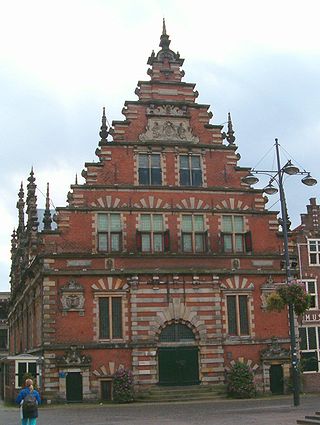
The Vleeshal is a historical building dating from 1603 on the Grote Markt in Haarlem, the Netherlands.
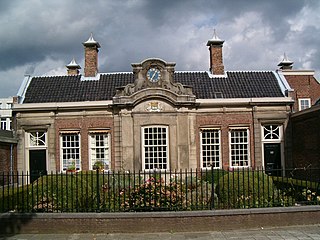
The Hofje van Noblet is a hofje in Haarlem, Netherlands.

The Hofje van Staats is a hofje in Haarlem, Netherlands, on the Jansweg 39, close to the Haarlem railway station.
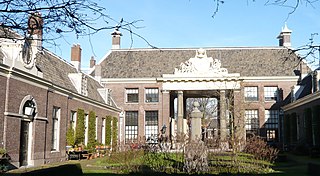
The Teylershofje is a hofje in Haarlem, Netherlands with 24 houses.
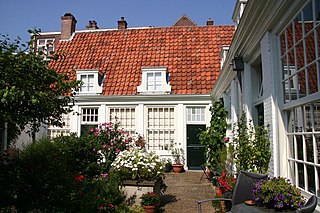
Hofje van Guurtje de Waal is a hofje in Haarlem, Netherlands.

The Hofje van Willem Heythuijsen is a hofje in Haarlem, Netherlands. It was founded in 1650 by the testament of Willem van Heythuysen on the site of his summer residence outside the city walls of Haarlem on land that was considered Heemstede property until it was annexed in 1927. It is one of the few hofjes of Haarlem to be built outside the city walls. It has a 'T' shape and has a small open courtyard and a garden still intact.

The Wijnbergshofje is a hofje in Haarlem, Netherlands, on the Barrevoetstraat.

Frans Hals Museum - Hal is one of the two locations of the Frans Hals Museum, located on the Grote Markt, Haarlem, Netherlands, where modern and contemporary art is on display in alternating presentations. The emphasis is on contemporary photograph and video presentations, with the focus on Man and society.

The Museum De Cruquius occupies the old Cruquius steam pumping station in Cruquius, the Netherlands. It derives its name from Nicolaas Kruik (1678–1754), a Dutch land-surveyor and one of many promoters of a plan to pump the Haarlemmermeer dry. Like many well-educated men of his time, he latinized his name to Nicolaus Samuel Cruquius. During his lifetime the issue of the Haarlem Lake and how to pump it dry was international news, as the following excerpt from the Virginia Gazette on 31 May 1751 illustrates:

The Vrouwe- en Antonie Gasthuis is a hofje on the Klein Heiligland 64a in Haarlem, Netherlands. It is open on weekdays from 10-17.00.

The Janskerk or St. John's Church is a former church in the Dutch city of Haarlem. Today it houses the North Holland Archives.

The Nieuwe Kerk is a Dutch Baroque Protestant church in The Hague, located across from the modern city hall on the Spui. It was built in 1649 after the Great Church had become too small. Construction was completed in 1656.

The Stedelijk Gymnasium Haarlem or the Latin School of Haarlem is a secondary school in Haarlem, Netherlands. The school was founded in 1389 and is therefore one of the oldest schools in the world. The school offers voorbereidend wetenschappelijk onderwijs exclusively and is an independent gymnasium enrolling 822 students and 95 teachers, for a teacher/student ratio of 8.6.

The Waalse kerk is a historical church dating from the 14th century on the Begijnhof in Haarlem, Netherlands.

The Lutherse kerk in Haarlem is a Lutheran church dating from the 17th century on the Witte Herenstraat in Haarlem, Netherlands.

Grote or Sint-Laurenskerk is a landmark formerly Protestant church in Alkmaar, Netherlands, now in secular use. The building is located on the Koorstraat. It is mostly closed in the winter and open for tourists in the summer months or by appointment.

Iepenrode, or Ipenrode, is the name of a villa in Heemstede, the Netherlands, between the Leidsevaart and Herenweg, located north of Huis te Manpad and south of Berkenrode. It was once the summer home of various mayors (burgemeesters) of Haarlem and is currently privately owned.

The Doopsgezinde kerk is a historical hidden Mennonite church dating from the 17th century between the Grote Houtstraat, Peuzelaarsteeg and the Frankestraat in Haarlem, Netherlands.
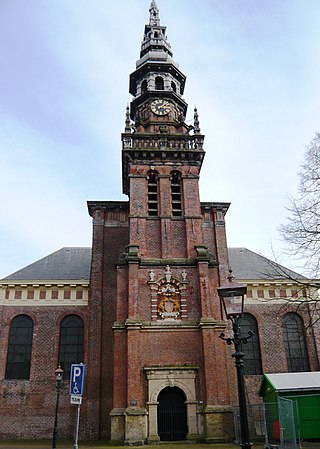
The Nieuwe Kerk is a historical Protestant Reformed church dating from the 17th century on the Nieuwe Kerksplein in Haarlem, Netherlands.